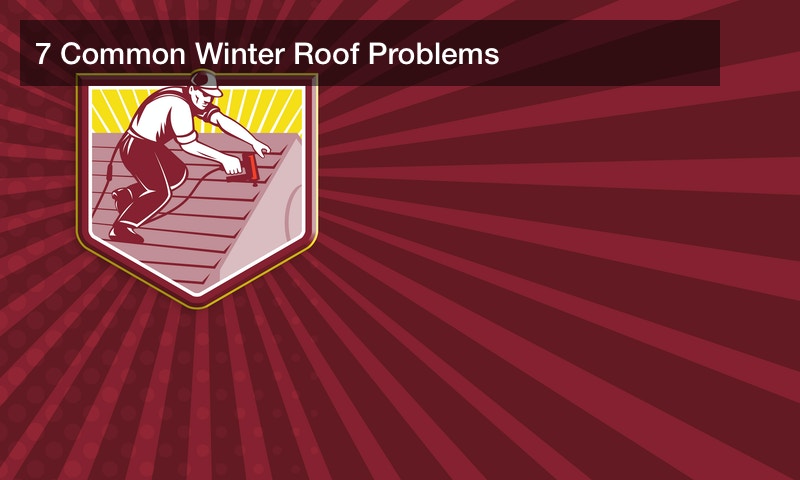
Your roofing can take a beating during the winter season. From icicles, ice dams to leaks, many issues can haunt homeowners during the cold season. This is part of why home improvement spending rose by 14% in 2017, as many homeowners sort to improve their roofs.
Fall is often the best time to schedule repairs before the cold season begins. This article looks at the most common winter roof problems you are likely to encounter.

Ice Dams
As the ice begins to melt, the accumulation of snow on the roof can hinder its drainage. The gradual flow gives time for water to find its way into your home.
It is one of the most common roof problems in winter, especially for flat roofing. Most roofs with a low gradient can last for at least 20 years. However, they need the expertise of a professional to minimize the risk of leaks.
The most prevalent leaks will often be around the flashing, plumbing vents, chimneys, and skylights. Even with slanted roofs, sub-standard craftsmanship is usually the reason behind frequent incidences of leaks.
To deal with the common winter roof problems, you could choose a durable and waterproof option such as SPF roofing. After the installation, the roof is a continuous solid surface with no entry points for water and moisture.
It also acts as an insulation, which minimizes issues with condensation and moisture problems. It is energy-efficient and can considerably cut down the energy consumption of your home.
Spray Polyurethane Form (SPF) material is resistant to cracking and splitting. It is particularly suitable for flat roofs that are often plagued by flooding problems. However, you should ask your roofing contractor to assess your location and climate to determine if SPF is ideal for your home.

Leaky Flashing
Flashing describes the metal strips that drain away water from parts of your house susceptible to water and snow damage. Their placement is usually on elements that intersect with the roof, such as chimneys and valleys.
If there are indications of wear and tear, the caulk will loosen further when winter arrives. The deterioration may happen faster due to temperature fluctuations. Loose flashing can leave gaps, which create spaces for water to seep in when there is an ice dam.
The flashing may also deteriorate as a result of sub-standard installations. For example, installers may not have left room for the extension of joints or counter flashing. The expansion and contraction will inevitably force the metal strips to loosen. The gaps will allow moisture into parts of the building and roof.
The metal strips can deteriorate at a fast rate. That is why leaky flashing is one of the most common winter roof problems. It is advisable to repair roof leaks when you spot them to prevent further damage. You should also inspect the flashing after every six months to keep your property safe and efficient for longer.
Condensation
Another common winter roof problem is condensation, usually resulting from poor ventilation. Moisture circulates and can’t escape, so it accumulates on parts of the roof’s structure. Vents can give you a false sense of confidence, but the level ventilation they provide is not always sufficient. A professional roofer should evaluate if there is enough open area in the attic to allow for adequate airflow.
The warm air circulating will condense when it comes into contact with cooler parts of your home during the cold weather. Condensation most often occurs along the sections of the roof slope. It is also likely to be along the underside of the roof’s sheathing.
You may notice dark spots on the structure of your house. Such discolorations are not always easy to discern, but they are often an indication of a mold and mildew infestation. Removing the mold may require a roof cleaning service professional who can map the spread of the microbial growth.
Some homeowners use ventilation fans to pull out warm air from the attic and to stop condensation on its tracks. However, the wrong placement of the fan may force more humid air into the building. Unless you understand the source of the moisture, you may end up making the problem worse.
The insulation materials under your home’s foundation are permeable to vapor emanating from under the soil. It can allow moist air in humid areas to find its way into the house, especially during hot summer days. The humid air will then condense as the cold weather commences.
A roofing contractor can evaluate the insulation and airflow within the building. Remember that the age and the nature of the construction of the attic may accelerate the accumulation of moisture. Sub-standard installation of the insulation may also play a crucial role in speeding up the process of condensation.
Another surprising culprit that may also be the source of condensation is wood. Although firewood may seem dry, it typically is damp within its fibers. Rising temperatures will gradually release the moisture into the room.
That’s why you should always have adequate ventilation where there is a significant amount of wood. Airflow will preserve the timber for longer and will keep it dry so that it is ready for the furnace come winter.

Temperature Variation in Your Interior
The temperature difference between various parts of your home is another factor behind common winter roof problems. Many households have rooms that they rarely use, such as the closet, attic, or the mother-in-law suite.
The warm air movement across the home will condense when it comes into contact with cooler parts adjacent to those rooms. Un-insulated walls that are between frequently used and vacant spaces may further raise the temperature difference. Condensation can also occur in areas around the windows, doors, ceilings, and the floor.
Activity in the home is the other common factor that can increase the risk of condensation. You may have more frequent incidences of condensation when there has been a spike in your home’s occupancy.
The process of condensation may speed up as a result of other activities taking place in the building. For example, energy-saving showerheads may generate more vapor than conventional appliances. Also, the clothes dryer can release significant amounts of moisture.
If your home has insulation, you will need to have parts of the building evaluated by a professional roofer. The insulation material may shift due to expansion and contraction or impact. When that happens, there is a higher likelihood of temperature differences and subsequent condensation.
You also need to ensure that you have the right grade of insulation material for your climate. Different parts of the house, such as walls, ceilings, and doors, will also need the appropriate insulation to be effective. Addressing the issue of insulation in autumn will shield against the common winter roof problems.

Destructive Windstorms
Occasionally, winds may get strong enough to rip out the shingles and critical parts of the property. Blizzard storms are usually 35 miles per hour, which is enough to wreak havoc on your roofing. Even new roofs can sustain a lot of damage if the wind continues for a considerable amount of time.
If the installation is more than 15 years old, it will develop leaks and a host of other common winter roof problems. Remember that the winds carry fragments such as ice, hail, and stones, among other debris. These objects will be ramming on your roof at high speeds for more than an hour.
Continuous winds may also create multiple layers of ice, which increases the weight exerted on your roof. The wind deposits snow, creating ice dams and subsequently weakening the underlying structure. The weight can test the load-bearing capacity of your house structure to its limits. There may be cracks around beams, and the doors and beams may warp.
Your home will, at least, need an inspection by a certified roofer after the storm to prevent common winter roof problems. Many parts could sustain damages, and the keen eye of a professional should spot them. If your installation is old and worn out, it may be time to consider re-roofing services.
Snow and Icicles
Another common winter roof problem is icicles. You may see them when there is sunlight outside, and the temperatures are at freezing point. They can form when warm air from the interior rises to melt the ice on the roof. For that reason, icicles frequently occur about the same spot on your house.
Even though they seem alluring on your house against the snow outside, they can pose a considerable risk. Icicles will shatter windows and windscreens when they fall. They can also rip out the gutters and injure people walking by.
Icicles form when ice melts and then freezes again, creating ice dams in the process. The icicles act as a wall preventing water melting further up the roof from moving. As a result, there is an accumulation that will eventually create pools on your roof. The pooling water can be devastating to the underlying structure of the roof.
If you plan to remove the icicles, you should be conscious of the risk of slip falls. The roof can be dreadfully slippery when there are such ice formations. You can remove the icicles on your roof by shaking it gently. However, always avoid standing under the icicles as they can fall and injure you.
You can use a ventilation fan if you anticipate that the temperatures will go below freezing for your climate. You can direct cool air between the spot where the gutter and the roof meet for the best results. Reducing the heat difference will minimize condensation.
Branches and Debris
Another common winter roof problem is wind launching projectiles such as branches and stones onto the house. The debris can leave a dent on the siding and may ruin your shingle roofing. Even low winds may have an impact that could cause the paint to peel off from the siding.
If you have lots of trees on your property, you should trim off the branches. Some branches can brush off against the roof, causing extensive damage. Cut down any trees that are within six feet of your roof to minimize the risk of common winter roof problems.
Remember to clear your yard before winter and preferably in autumn. Containers, twigs, tools, and hoses should not be lying around on your lawn. If there is already any sign of damage, organize for asphalt shingles repair. It is easier for defective parts of your roofing to loosen from mild winds.
Replacing Versus Repair
The earlier you address the issue, the more likely you will avoid the common winter roof problems above. In the cold season, seemingly minute problems like loose flashing can create complications that will eventually damage your home.
However, you’ll have two options; to schedule for repair or replace your roofing. You don’t want to spend more than you should, but on the other hand, you can’t overlook critical repairs.
The installation materials and your roof’s condition are some of the factors that will determine your choice. For example, shingles are tricky to handle during the cold season. The asphalt tiles become brittle in freezing temperatures, making them harder to cut.
In cold temperatures, therefore, installation is more complicated and, consequently, more costly. It could be that your roof requires asphalt shingle repair rather than a replacement. The contractor may apply thermal sealing on the tiles to protect against moisture damage before the cold season.
Nevertheless, you should organize for repairs as soon as you spot problems. Your roofing contractor can provide you with the options and help you determine if you need a replacement. When the damage is too extensive, there may be no option but to get new roofing to protect your home. As long as a professional assessment informs the decision, it is always worth it in the long run.
Bottom-Line
You can prevent most of the common winter roof problems with maintenance and timely repairs. You ought to understand your limits before you attempt to fix your roofing. You can damage parts of the roof or slip and injure yourself. Sometimes it is better to consult a certified contractor.




Leave a Reply
You must be logged in to post a comment.